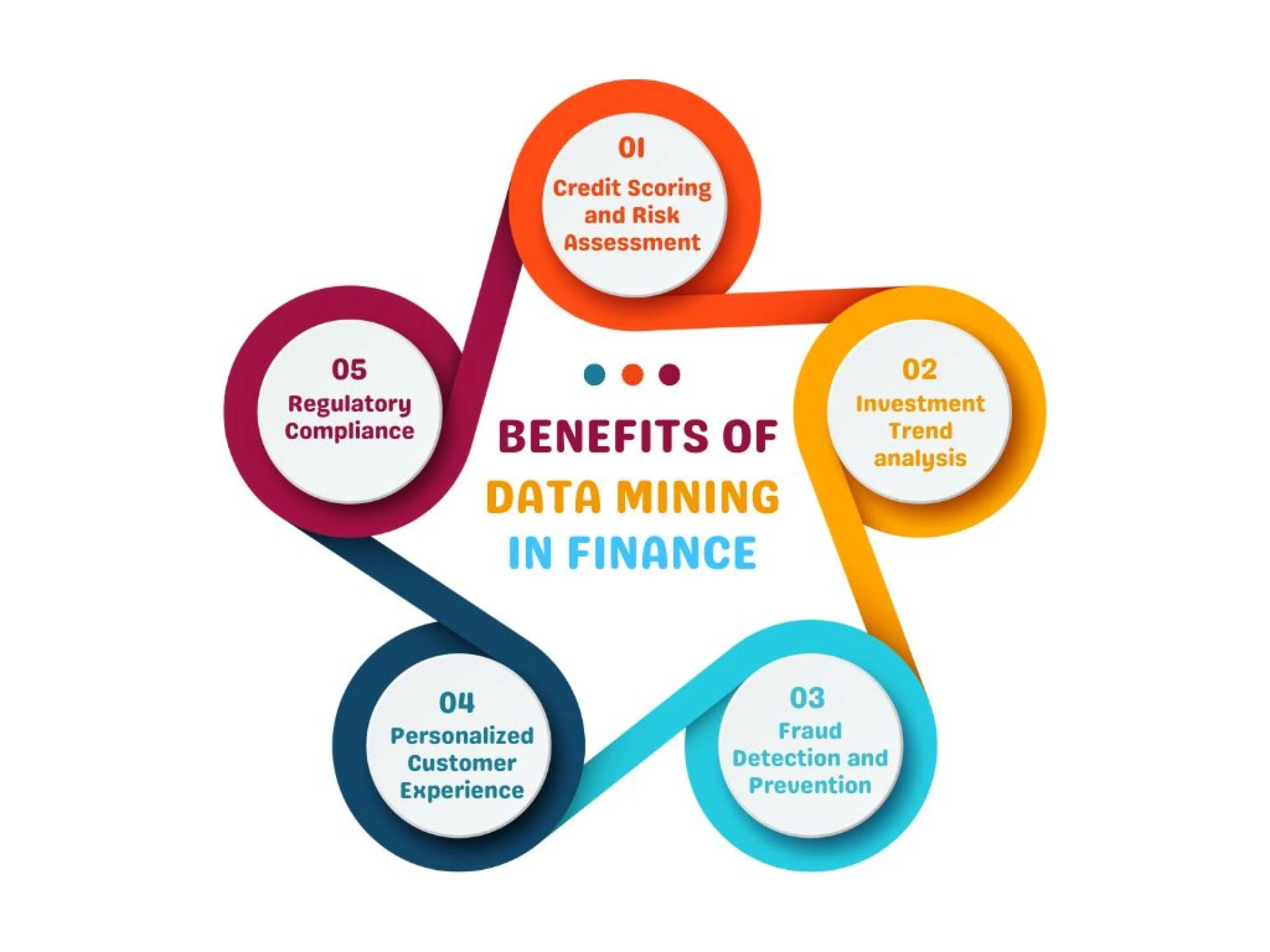From investment firms and insurance companies to banks and financial institutions, the finance sector is highly data intensive. Every transaction, market movement, customer interaction, etc., generates valuable data that drives decision-making. However, this data cannot be used for strategies as it is usually unstructured and inconsistent. Nuggets of insights have to be mined from large datasets, thus calling for data mining services!
Yes, that’s right! Data mining is the best way to gain actionable insights from complex datasets. The process involves discovering trends, patterns, relations, and anomalies from raw datasets. These insights enable finance companies to respond instantly to market changes or security threats.
In other words, data mining is a knowledge discovery process that lets businesses uncover actionable insights. Moreover, as competition intensifies and regulatory requirements become stricter, data mining becomes more important than ever. Credit card companies, for example, use real time data mining and analysis to identify fraudulent transactions, and investment firms use it to forecast market trends.
Without the ability to identify patterns and forecast trends, companies risk falling behind in a competitive market, losing customer trust, and failing to meet regulatory standards. We're sure no company can afford such losses! That said, stakeholders must know the two broad categories of data mining and how these help financial institutions.
Broad Categories of Data Mining
As an intricate process of discovering valuable insights from vast and varied data, it is broadly classified into two categories, both of which are elaborated below. Take a look:
A) Descriptive Data Mining
As the name suggests, descriptive data mining helps decode the past by identifying trends and patterns in historical data. Banks, for instance, use this to understand their customer’s past spending behaviors. Another practical application of descriptive data mining is detecting unusually high transactions, thereby safeguarding banks and other financial companies against potential fraud.
B) Predictive Data Mining
Unlike descriptive mining, which uses historical data to understand past behaviors, predictive mining uses historical data to predict future events. Financial organizations use predictive mining for credit scoring. Here, a thorough analysis of a customer’s past financial behaviors helps predict their future creditworthiness. Another example is banks predicting a customer’s likelihood of defaulting on future loans by analyzing their past loan repayments and spending patterns.
The role of data mining in the finance sector becomes more important as the volume of data explodes. After all, it's not just managing data but harnessing its power to make informed decisions that help financial organizations remain competitive.
That said, various data mining techniques are used to discover useful insights from data. Each technique has a unique purpose, ensuring financial institutions stay ahead of the competitive curve.
Key Data Mining Techniques in Finance
Data mining techniques are divided into three groups: supervised, unsupervised, and semi-supervised learning. Each of these groups has different methods for specific types of data analysis. Take a look:
1- Supervised Learning Techniques
In supervised learning, ML algorithms are trained using labeled data. The “labels” provide a context to the raw data, enabling algorithms to learn and perform the desired actions. And that’s how the model makes predictions based on new, unseen data. The techniques majorly involved here are:
Classification: This method involves categorizing data into pre-defined groups. ML systems like support vector machines and decision trees enhance the accuracy of these classifications. Based on their credit history, financial institutions use this technique to determine if a loan applicant falls into a “high-risk” or “low-risk” category.
Regression: Regression analysis allows financial analysts to predict future outcomes by identifying relationships between variables. For example, traders and investors use it to forecast stock prices based on historical data and market conditions. Another practical application of regression analysis is forecasting a customer’s future credit score.
2- Unsupervised Learning Techniques
Contrary to supervised learning, unsupervised learning deals with datasets where the outcome variable is unknown. The purpose here is to find patterns, correlations, and anomalies within the datasets.
Clustering: This technique groups data points with similarities or the groups that occur naturally within the datasets. Clustering is best used for customer segmentation based on their spending habits, investment preferences, and risk tolerance. The result? More personalized marketing and service offerings.
Association Rule Mining: This technique identifies hidden relationships between variables in large datasets. One of the well-known examples is the "beer and diapers" association in supermarket data. In finance, association rule learning is used to identify relations between different investment instruments and trading behaviors.
Pattern Recognition: It identifies patterns within vast datasets. These can either be observed using mathematical calculus or by applying algorithms. Finance companies use this technique to identify recurring trends in financial transactions and make informed decisions.
Anomaly and Outlier Detection: This technique identifies data points that show significant deviations from the norm. This way, businesses can spot fraudulent activities and transactions. Moreover, anomalies and outliers can be detected using unsupervised as well as supervised learning.
3- Semi-supervised Techniques
Semi-supervised learning is a blend of both supervised and unsupervised learning. This is useful when unlabeled and labeled (fraudulent and legitimate) transaction data are mixed. One of the key techniques here is:
Neural Networks
Inspired by the human brain, neural networks efficiently handle complex, non-linear data. Due to this, neural networks are used in tasks like fraud detection, where identifying subtle anomalies in real time is important.
Given the sensitive nature of finance, data mining is just the right tool to uncover patterns, relations, and deviations from the norm. These insights offer businesses a plethora of benefits, ranging from credit assessment and risk mitigation to informed investment decisions.
The Benefits of Data Mining in Finance

I- Credit Scoring and Risk Assessment
Determining an individual’s creditworthiness is an important and equally challenging task, as fixed parameters, including existing loans and income sources, aren’t helpful. Other than this, financial institutions also need to check their social behavior, alternative income sources, and more. That’s where the expertise of a seasoned data mining company helps, gauging intense data from different angles, such as social patterns. Thus, stakeholders can make informed loan decisions, eliminate default rates, and minimize bad debts.
II- Investment Trend analysis
As investment dynamics change, investors are looking for ways to reap maximum profits from their investments. Rather than relying simply on predictive data, they’re making rational decisions, and data mining plays a key role here. It enables the stakeholders to analyze historical market data and identify patterns that indicate future trends. This is important for traders and investors who need to make quick, informed decisions.
III- Fraud Detection and Prevention
The financial industry is gearing up to combat fraud, including money laundering, counterfeiting, bad transactions, fake credit cards, etc. And real-time data mining is the best option to identify suspicious activities as they occur. ML algorithms flag anomalies in real time by analyzing transaction patterns and cross-referencing them with historical data. Thus, the authorities can take quick action in time.
IV- Personalized Customer Experience
Customers expect all the products/services tailored to their needs, and finance is no exception. Data mining helps segment customers based on behavior, preferences, and demographics. Accordingly, financial companies tailor their offerings to resonate with specific audience groups. For instance, a bank can recommend specific investment plans to customers based on their spending and saving patterns.
V- Regulatory Compliance
The finance industry is heavily regulated with strict requirements to ensure transparency and accountability. Data mining tools help institutions monitor transactions, generate compliance reports, and identify potential regulatory violations. This reduces the risk of penalties and reputational damage.
Closing Lines
Data mining is important for the finance sector as it helps discover trends, patterns, and relations. These insights help stakeholders calculate risks and creditworthiness, detect and prevent fraud, and deliver seamless customer experiences. Moreover, they can make informed investment decisions that lead to maximum profits.
Even though the process benefits businesses, it is time-consuming and resource-intensive. Thus, the alternative way to get insights to outsource data mining services. The professionals have the required potential to mine useful insights from large datasets in real time, enabling companies to remain competitive in the dynamic finance landscape.


